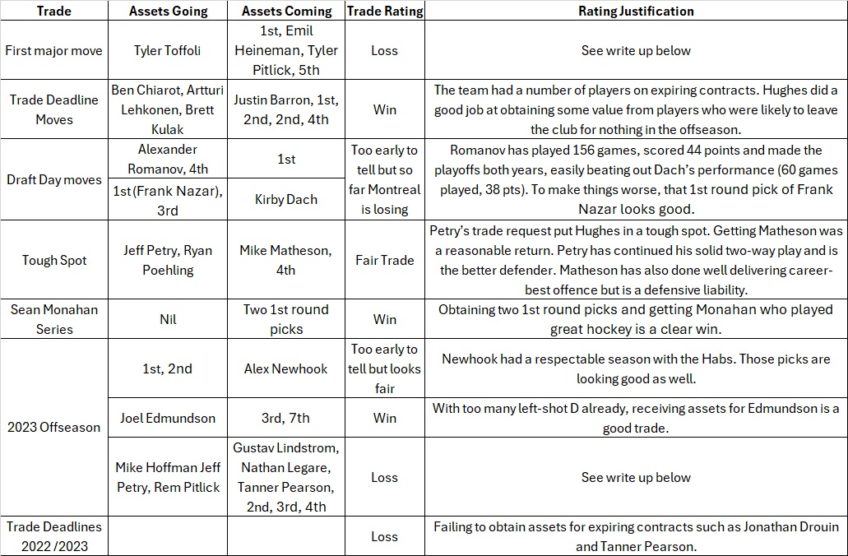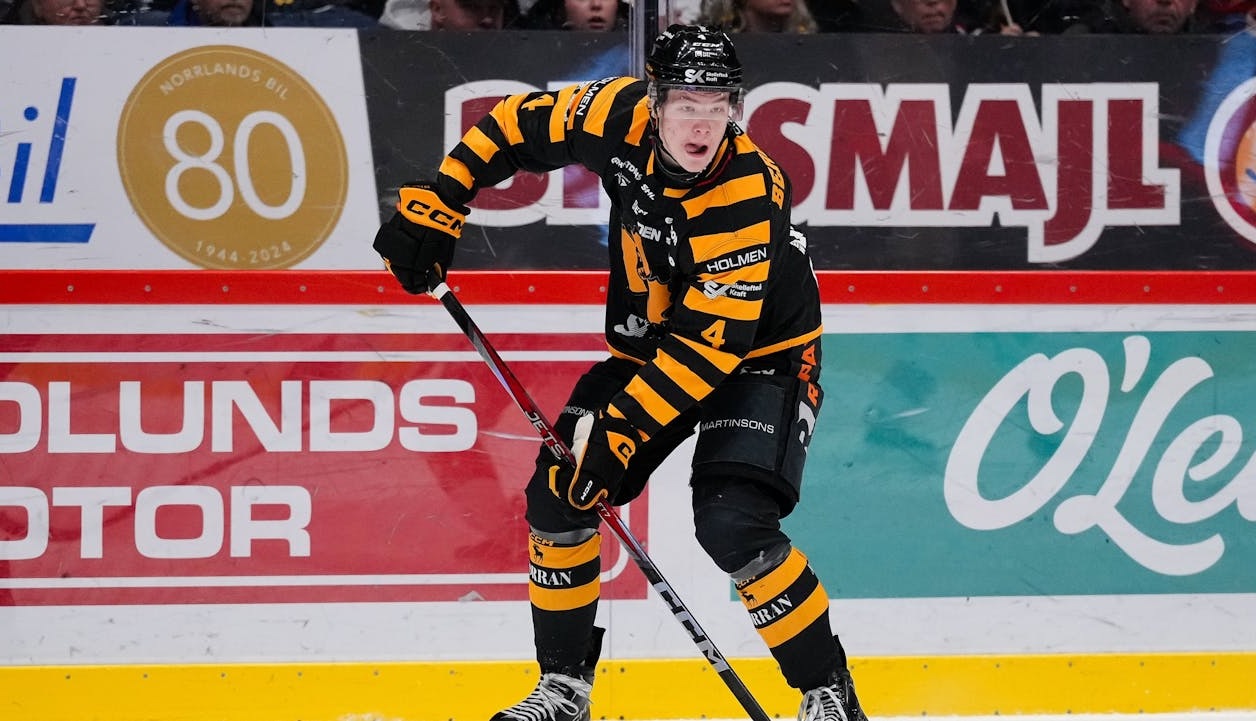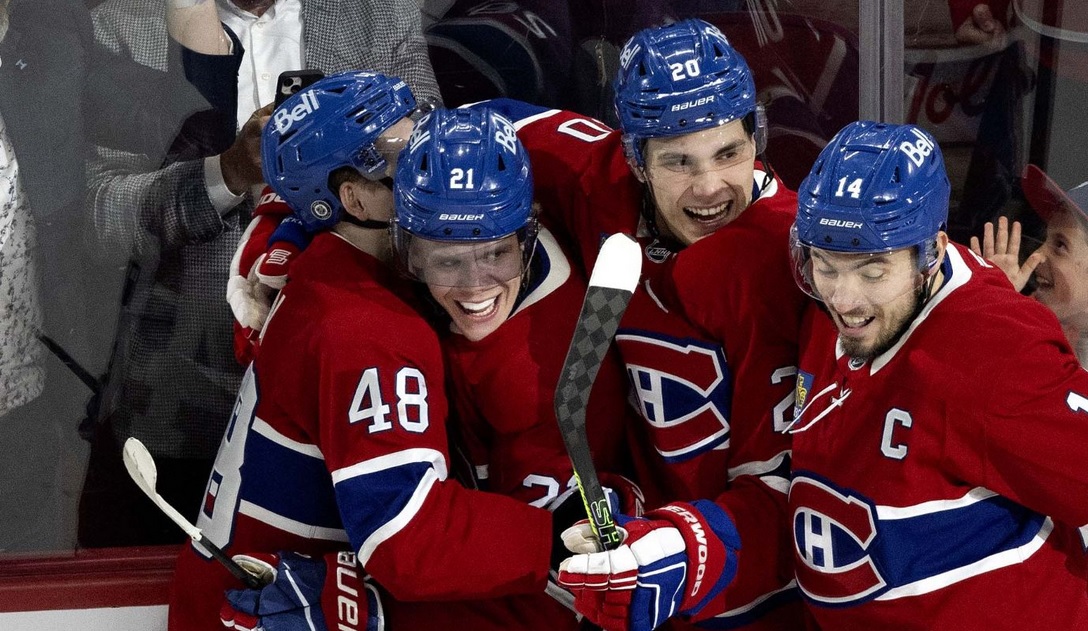HabsWorld.net --
Marc Bergevin was the general manager of the Canadiens from 2012 to 2021. During that time, he accomplished many things for the team, with strong performances in the regular season and playoffs (including the Stanley Cup Final in 2021) and finished second in voting for general manager of the year on two occasions.
After a horrific start to the 2021-2022 season, Montreal ownership brought in Jeff Gorton in a newly-created role of Executive Vice President in November 2021. Gorton is an exceptionally experienced executive with over 10 years of assistant and/or general manager roles with NHL clubs. In January 2022, Gorton hired Kent Hughes as the team’s general manager. Hughes was a very successful player agent but is a complete rookie with no management experience in the NHL or any large organization. In February 2022, the team hired Martin St. Louis as the head coach. While St. Louis had a long and highly successful playing career, he had no coaching experience.
As new management has had almost three full seasons to craft the team to their liking, it’s time to gauge progress and evaluate the decisions new management has made. The three major components are team performance, asset management, and player development.
Team Performance
The first and really the only thing that matters is how the team has performed. In order to measure performance, we’ll compare the results of new management against those of previous management. The last full season under the old management was the 2020/2021 season where the Habs finished 18th overall and went to the Cup Final. So that will be the benchmark to compare against.
The 2021/2022 season is the first under new management as Gorton was hired in November. While some may argue this was a transition year and previous management is more responsible for team record, I believe otherwise. Even though the team was off to a horrific start, Gorton had plenty of time to make changes to turn things around and compete for the playoffs.
Consider that on January 2, 2019, the St. Louis Blues were dead last in the regular season standings. Management made changes and decided to compete. They finished 12th overall in the regular season and went on to win the Stanley Cup. Or the Edmonton Oilers who were third from last on November 25, 2023, finished ninth overall and made it to the Stanley Cup Final this past season.
For the Habs coming off a very successful trip to the Final, the core pieces of a winning team were in place. Gorton could have made changes to compete but instead chose to rebuild, trade away valuable players, and forfeit the season in order to improve their draft position. As a result of these decisions, the record for that season belongs to new management.
The following table summarizes the team record for the last four years with the last three under new management. In looking at the record, new management has finished dead last and 28th overall twice as compared to 18th overall under previous management.

If we expand the metrics to see if the team is at least being competitive, things don’t look much better. Looking at games where the team has lost by more than three goals shows a significant decline in management’s three years at the helm. The most recent season is better so at least there’s hope that the team is moving in the right direction.
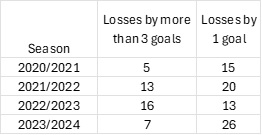
Goal differential also shows terrible results for the team over the last three years compared to the previous management’s record.
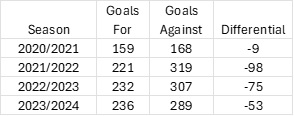
Finally, we’ve found one team stat – the penalty kill – where the team’s performance actually compares well to previous management.
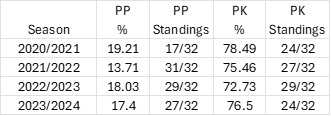
Verdict: While the trend does give some hope over the last two years, the team performance is abysmal and far worse than under previous management. There is simply nothing here for new management to be proud of.
Asset Management
Once new management started a rebuild, team performance was clearly not important, and the priority for them shifted to asset management. Management would need to turn current players into valuable draft picks or prospects. The following table rates the more significant moves that new management has made along with a brief explanation. In some cases, results won’t be known for years as players and draft picks can take years to develop.
First Major Move: In what should only be described as a knee-jerk reaction to do something, the rookie GM’s first major move was a surprise to everyone by trading Tyler Toffoli. Toffoli was a strong player for the Habs and there was a lot to like about him including being one of the team’s top scorers, great chemistry with Nick Suzuki and Cole Caufield, and a team-friendly contract with multiple years remaining.
After trading Toffoli, the Canadiens’ offensive struggles intensified as the team posted a negative goal differential of 128 over the next two seasons and struggled to find anyone who could play with Suzuki and Caufield. On the other hand, Toffoli continued his strong play scoring 128 points over those two seasons, which would have made him the team’s top scorer outside of Suzuki. In return for Toffoli, the assets Montreal received have yet to register a point in the NHL.
The decision to trade their top winger Toffoli with no replacement, is one of the key reasons Montreal finished at or near the bottom of the standings for three straight seasons.
Pointless: After trading Petry the previous year (due to Petry’s trade request) new management somehow thought it was a good idea to re-acquire him along with a fourth NHL goalie (Casey DeSmith) in order to move Mike Hoffman – who was considered an extra forward. But now Hughes was then forced to trade Petry and DeSmith but is in a terrible negotiating position and couldn’t even give these players away. He was forced to retain salary on Petry and take back a bad contract/extra forward in Tanner Pearson. While the team did pick up some draft picks, they ended up back where they started (with an extra forward) but also had to use up a valuable salary cap retaining slot. From the outside it makes me question what exactly was the purpose and the strategy?
Verdict: New management has made some good moves but they are losing on too many others to give much confidence. In time, perhaps some of the assets will develop and the moves will look better in retrospect. One can hope.
Player Development
The last area to evaluate new management is their self-professed change in player development.
New management has brought in several new coaches and training staff to better assist prospects in their development. This is a good first step. And they also seem to be taking a cautious approach and allowing prospects to develop rather than rushing them into the NHL. Prospects like Logan Mailloux, Jayden Struble, Sean Farrell, and Owen Beck have all been allowed to develop in junior or the AHL and are having success. Time will tell if the additional coaches and putting the prospects in positions where they can be successful will pay off. Certainly, it’s an improvement from what fans saw under previous management where the likes of Victor Mete and Jesperi Kotkaniemi were rushed into positions before they were ready and will likely never develop to their full potential.
But new management isn’t perfect either and there are also examples of rushing players or putting them in high-risk circumstances. Take for example the 2022/2023 season in which the team regularly played with four or five rookie defensemen (Guhle, Harris, Kovacevic, Xhekaj, Barron). New management did not make any trades or bring in any help to ease the transition. Instead, they took a sink-or-swim approach and let the rookies learn the hard way. We’ll never know if the usual approach of a year or two of seasoning in the AHL would have been a better decision for some of these rookies in the long term.
Similarly, first overall pick Juraj Slafkovsky had a horrific first year in the NHL in 2022/2023. To anyone watching, he was clearly out of his depth and was not competitive in any aspect of the game. Even despite his size he was regularly knocked around until he was mercifully injured after only 39 games. Rather than send him to the AHL or overseas where he could develop in a more successful environment, management continued to let him struggle for far too long. No other NHL team allowed their top draft pick to play in the NHL that year. Slafkovsky has turned things around in the second half of last season so there’s hope that his development is back on track. If so, he’s turned things around in spite of management’s approach – not because of it.
Verdict: While there are some signs of doing things differently from previous management, there are also examples where new management is making the same mistakes and putting players in less-than-ideal circumstances.
Summary
When it comes to team performance, new management is clearly far behind previous management’s record. They have chosen the rebuild path with the hope that asset management and player development will eventually make the team stronger. But there are too many examples of poor decision-making in these areas to be confident the team is on the right path.
As a final point, consider the decision to carry three healthy goalies on the roster this past season – something that is highly unusual in the NHL.
By keeping three goalies, management played Jake Allen once every 10-11 days (on average) making sure he was rusty and out of game shape. Not surprisingly his performance suffered with below-average numbers that quickly improved after he was traded and played more regularly.
Cayden Primeau only played in 23 games when he wasn’t watching from the press box. This is hardly an ideal situation for player development. How much this affected his development will never be known but his numbers also improved once he played more regularly.
When management did trade Jake Allen, they got a third-round pick but had to retain salary. I’d be surprised if they weren’t offered that deal or better earlier in the season when a number of NHL teams had goaltending challenges.
This situation seems to be a good summary for the Canadiens’ new management. They made a highly unusual decision to carry three goalies which resulted in sub-optimal playing schedules. As a direct result, team performance, trade value, and player development all suffered. It’s hard to think of a way in which the team was better off by carrying three goalies!
So, whether we’re looking at the three-goalie situation, or the decision to keep Slafkovsky in the NHL, or the trades of Toffoli and Pearson, in each case it’s hard to see how the team was better off. Management has had nearly three full seasons to make the team better but it’s not all that obvious that the changes they are making are moving the team in the right direction.

